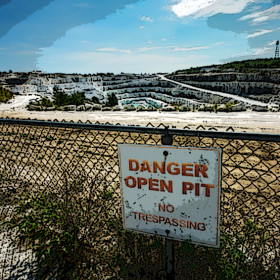Terroir; Between Medoc & A Hard Place.
Chapter Eleven. Part Four.
 Mineral is one of the terms often used when describing old-world wines. Whether it is perceived as graphite or clay in young red wines from the Medoc or as chalky limestone in Loire Valley whites, minerality often finds its way into wine. I’d like to tell you the romantic tale of how I discovered this important facet of terroir when I was travelling through the vineyards of France, but then I’d be lying.
Mineral is one of the terms often used when describing old-world wines. Whether it is perceived as graphite or clay in young red wines from the Medoc or as chalky limestone in Loire Valley whites, minerality often finds its way into wine. I’d like to tell you the romantic tale of how I discovered this important facet of terroir when I was travelling through the vineyards of France, but then I’d be lying.
I learned about minerality as a trespassing juvenile delinquent in the cornfields west of Chicago. These cornfields were littered with abandoned stone quarries that – once the water table had been breached – filled with crystalline spring water. The resulting oasis was a welcome relief from the oppressive Illinois heat, providing you were willing to ignore the threatening signs and climb a chain link fence.
I passed many summer afternoons immersed in those mineral-infused waters, filling my olfactory memory banks with impressions of slate, iron and limestone and my belly with impressions of cheap beer. I’m not sure which tasted more metallic.
Years later I started paying attention to what I was drinking when I learned that girls liked wine and guys who didn’t put ice in it. I discovered some wines struck a familiar chord and I would think, “What is it about this wine that reminds me of an Illinois quarry?” In one of those Eureka moments! it hit me – certain wines taste and smell like minerals! Who knows, if I hadn’t been a trespassing juvenile delinquent, I may never have grown into the smart-ass sommelier I am today.
There are hundreds of examples of environmental factors that affect flavor and give credence to the concept of terroir. For example, Pouilly-Fumé is a wine producing region located on the Loire River in northern France. The wines of Pouilly-Fumé can be distinctly different from wines produced across the river in Sancerre even though they are both made from Sauvignon Blanc and share a similar climate. Pouilly-Fumé often displays a smoky quality that resembles flint or even gunpowder. This attribute can be traced to the unique terroir of Pouilly-Fumé and more specifically to the deposits of silex or flint present in the limestone beneath its vineyards. Trace elements are absorbed by the roots of the grape vine, passed into the grapes, and survive the fermentation process to appear in the finished wine in your glass. Now that’s terroir with staying power.
Another example of the formidable link between the land and the wines produced there can be found in the unique soil and resulting minerality apparent in the wines of Chablis. There is a vast ribbon of chalky limestone that runs from the White Cliffs of Dover in England, through Chablis in northern Burgundy, and into Sancerre. In Chablis, this chalky deposit combines with Kimmeridgien clay formed during the Jurassic era and imparts a chalky minerality to the finished wines. The Jurassic era, as you’re probably aware, was a prehistoric time period named after a popular movie.
Chablis is located along the 48th parallel, which is on the northernmost edge of viable grape production – at least for the time being. This exacting terroir produces austere, high acid wines that stand in stark contrast to the ripe, fruity Chardonnay grown on the 35th parallel in Albuquerque, New Mexico. This arid terroir is home to the Gruet Winery, makers of delightful sparkling wines. You may think New Mexico’s Chihuahuan Desert isn’t the best place for growing wine grapes but at an elevation of 4300 feet (some of the highest vineyards in the United States) this unique terroir does just that. Here, the temperature can plummet 30 degrees when the sun goes down, slowing the maturation process. If these vineyards were moved just a mile away Gruet might be making Blanc de Cactus, America’s first Sparkling Saguaro. (It’s succulent!)
Terroir works its magic in many ways and in every corner of the agricultural world. The vineyards of Chateauneuf-du-Pape are strewn with baseball-sized rocks called galets. The heat collected in these stones throughout the day is released at night, which facilitates the ripening of the grapes.
Hungary’s Hétszőlő and Nagyszőlő vineyards sit at the confluence of two rivers that I can’t spell because I’ve run out of umlauts (I worry that this blog might have too many accent marks, but then I realize I’m just being diacritical).¹ These rivers combine to create a unique climate that promotes the favorable development of noble rot, also known as Botrytis Cinerea. Despite what you might have heard, noble rot is a mold needed to produce the highly prized dessert wine Tokaji Aszú and is not a foot fungus common to aristocrats.
New-world vineyards also impart the telltale traits of their terroir to the wines they produce. The Humboldt Current brings frigid waters north to keep Chilean vineyards cool and arid. The chalky white stones of California’s Edna Valley impart a wet stone-like minerality to the wines raised there. Commercial wine production now takes place in all fifty states, and after sampling wines from many of these regions I can assure you that not all terroir is good terroir. In fact, some of the wines produced in these regions are downright terroirble.
¹If you actually get this joke, you need to get out of the library once in a while.






















